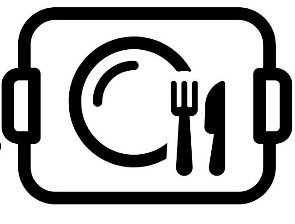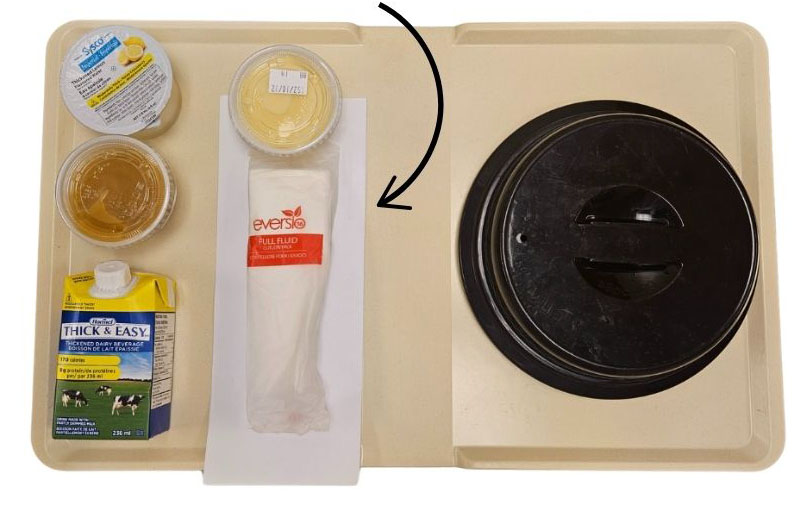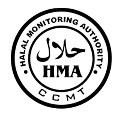Eating well in hospital
Your meal tray explained and tips for better eating
Food gives your body energy and nutrients. You may need more food than usual when you are sick.
Eating well in hospital helps you:
- Heal and get better faster
- Keep your weight and muscle mass
- Build a healthy immune system to fight infection
- Improve your balance and lower your risk of falling
- Reduce the number of days you stay in hospital
What food will you eat in hospital?
 Your health-care team will order foods for you based on your nutrition and swallowing needs. This is your meal order. Your meal order will affect the foods that come on your trays.
Your health-care team will order foods for you based on your nutrition and swallowing needs. This is your meal order. Your meal order will affect the foods that come on your trays.
Family, friends, and community agencies are welcome to bring you food to eat. Use this guide to learn more about what you can and cannot eat. Ask your health-care team if you have more questions.
What can you do to eat well in hospital?
- Ask for help if it is hard to reach your meal tray, open packages, cut foods or eat on your own.
- Ask your health-care team for more food if you are still hungry after your meal or between meals.
- If you feel full quickly, eat your meal first. Save your liquids to drink between meals.
- Review your meal tray ticket. Talk to your health-care team if:
- You have questions about your meal order
- Something is missing, like a need for vegetarian meals
Where can you find your meal order?
Your meal order is written on the meal tray ticket that comes with your meal. It is in the bottom left corner of the ticket. Look for two or more short codes in CAPITAL LETTERS above your name.
Together these codes make up your meal order.
PUREED = pureed texture
MODTHIK= moderately thick liquids
LO-POT = low potassium
|
1 Ptn Puree ham/ carrot/ turnip/ pot |
|
1 236ml MODERATELY thick milk 1 Ptn Pureed pineapple sauce 1 Ptn Thick cream of mushroom soup |
|
1 Cup MODERATELY thick water 1 Each High protein vanilla pudding 1 Ptn *Cutlery |
|
PUREED, MODTHIK, LO-POT Lunch Patient name Tuesday Room # 10/01/2024 |

Find the short code written on your meal tray ticket in this chart. It will tell you the full name of your meal order and a description of the foods that come on your meal tray.
If you have food allergies, you may see a code on your meal tray ticket that shows your food allergy.
|
Short Code |
Full Name |
Description |
|---|---|---|
|
Solid Texture |
||
|
REGULAR |
Regular |
All foods are served. |
|
These meals are for people that have trouble chewing or swallowing. Foods are moist with no water separation. |
||
|
MSOFT |
Mechanical Soft |
Easily cut with the side of a spoon or fork, like an omelette. |
|
CHOP |
Chopped |
Soft food cut into square pieces, about the size of a dice. |
|
MINCED |
Minced |
Food is broken down into very small pieces that can fit between the prongs of a fork, like cottage cheese. Minced food needs very little chewing. |
|
PUREED |
Pureed |
Completely smooth, like apple sauce, for people that have trouble chewing or swallowing. |
|
PURSNACK |
Pureed Snacks TID/No Meal |
Only 1 pureed food on a meal tray when small amounts are safest. |
|
NOMIXD |
No Mixed Consistencies |
Food in the dish is all one texture. Food that has both solids and liquids, like noodle soup or cereal with milk, is not served. |
|
Liquid |
||
|
THINLIQ |
Thin |
All liquids are served. |
|
The liquid consistencies below move slower in the mouth and throat for people that have trouble swallowing thin liquids, like water. |
||
|
MILDTHIK |
Mildly thick |
Runs quickly off a spoon, but leaves a thin coating on the spoon, like some fruit nectars. |
|
MODTHIK |
Moderately thick |
Drips slowly in dollops off a spoon, like liquid honey. |
|
EXTRMTHIK |
Extremely thick |
Sits on the spoon and does not flow off, like pudding. |
|
The amount of liquid served with the meals below is adjusted. |
||
|
Liquid Amount: |
Liquid served on meal trays is limited. For people that need to drink less liquids to manage medical conditions, like kidney disease. |
|
|
FL800 |
800ml |
|
|
FL1000 |
1000ml |
|
|
FL1200 |
1200ml |
|
|
FL1500 |
1500ml |
|
|
NOLIQUID |
No Liquids |
No liquids are served, for people that cannot safely swallow liquids. |
|
The liquid-only meals below are for people that have digestive issues, like vomiting, or need to have an empty stomach and intestines (bowels) before or after a medical test or procedure, like surgery. |
||
|
CLRFLD |
Clear Fluid |
Liquids that you can see through and do not have particles (pieces) in them like water, broth, and apple juice. |
|
FULFLD |
Full Fluid |
Clear liquids, milk, smooth milk products like plain yogurt, and fibre-free breakfast cereal, like cream of wheat. |
|
Other Modifications |
||
|
The meals below help with the management of different types of chronic (long-term) disease. |
||
|
HEART |
Heart Healthy |
Food high in fat and salt are not served. |
|
NOSUGR |
No Added Sugar |
Food with added sugar, like juice and sweets, are not served. |
|
HIGHPRO |
High Energy / High Protein |
Foods are added to increased energy (calories) and protein. |
|
For the meals below a specific amount of calories is served. Foods that can raise blood sugar, are spread over the day. |
||
|
Calorie Amount |
The number of calories served on meal trays per day. |
|
|
DB1500 |
1500 kcal |
|
|
DB1800 |
1800 kcal |
|
|
DB2200 |
2200 kcal |
|
|
For the meals below, a set amount of protein is served. For people that need this as part of management of kidney disease |
||
|
Protein Amount |
The number of grams of protein served per day. |
|
|
PRO65 |
65 grams |
|
|
PRO85 |
85 grams |
|
|
PRO105 |
105 grams |
|
|
The meals below served less of certain nutrients to help manage medical conditions. |
||
|
LO-POT |
Low Potassium |
Foods high in potassium are not served. |
|
LO-PHOS |
Low Phosphorus |
Foods high in phosphorus are not served. |
|
LO-FAT |
Low Fat |
Foods high in fat are not served. |
|
LO-RES |
Low Residue |
Foods that are high in fibre or difficult to digest are not served. Also called low fibre. |
|
LO-SOD87 |
87 mmol Sodium (2000 mg Sodium) |
Foods high in salt (sodium) are not served. |
|
NAS |
No Added Salt |
Foods served with no extra salt (sodium). |
|
LOW-TYR |
Low Tyramine |
Foods high in tyramine are not served. |
|
The meals below are to support recovery after gastrointestinal (organs that digest food) or jaw surgery. |
||
|
CORECTAL |
Colorectal |
Regular meals served with oral nutrition supplements. |
|
PSTMY |
Post-gastrectomy |
Smaller meals, served with snacks and oral nutrition supplements. Foods served have no added sugar. |
|
TRANSIT |
Transitional |
Smaller meals, served with snacks and oral nutrition supplements. |
|
WIRJAW |
Wired Jaw |
Food is pureed and thin enough to pass through teeth when they are closed shut. For people after jaw surgery. |
|
The meals below are for people preparing for a medical test |
||
|
LO-IODIN |
Low Iodine |
Food high in iodine is not served, to prepare for thyroid treatment. |
|
PETSCAN |
PET Scan |
Food has almost no carbohydrates and sugar, to prepare for a PET scan. |
|
The meals below are for people that are pregnant or breastfeeding. |
||
|
HYPERM |
Hyperemesis |
Food is plain for patients with severe nausea and vomiting. |
|
OBS |
Obstetrical |
Foods safe for pregnancy and breastfeeding are served. |
|
Calorie Amount |
For patients with diabetes (including gestational diabetes) a specific amount of calories is served on meal trays per day. Foods that can raise blood sugar, are spread over the day. |
|
|
OBD1800 |
1800 kcal |
|
|
OBD2000 |
2000 kcal |
|
|
OBD2200 |
2200 kcal |
|
|
The meals below are used to meet religious, cultural and person preferences. |
||
|
HALAL |
Halal |
Food follows guidelines for those of Islamic faith.
|
|
KOSHER |
Kosher |
Food follows guidelines for those of Jewish faith.
|
|
VEGAN |
Vegan |
Vegetarian foods with no animal products.
|
|
VEGLAC |
Vegetarian - Lacto |
Vegetarian foods and some foods that contain milk.
|
|
VEGOVO |
Vegetarian - Ovo |
Vegetarian foods and some that contain eggs.
|
|
VEGLO |
Vegetarian – Lacto-Ovo |
Vegetarian foods and some that contain milk and eggs.
|
|
VEGPESC |
Pescatarian |
Vegetarian foods and some that contain milk, eggs and fish. |
|
The meals below are used for allergies and intolerances. |
||
|
LACTORED |
Lactose Reduced |
Foods containing milk and milk products are not served. |
|
GLUTENFR |
Gluten Free |
Foods that have gluten (protein in some grains) are not served. |
|
The meals below are for people that are receiving nutrition by eating, and from IV or feeding tube. |
||
|
TPNDAT |
Total Parenteral Nutrition (TPN) - Diet as Tolerated |
For patients who get a meal tray and also get nutrients through IV. |
|
ENDAT |
Enteral-Diet as Tolerated |
For patients who get a meal tray, and also get nutrients through a feeding tube. |









